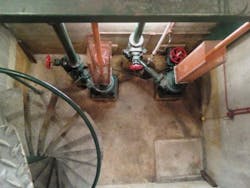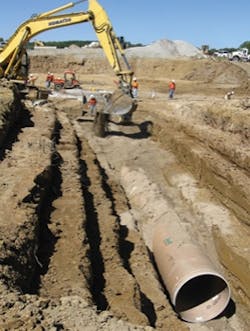By Everett Skipper
When a region-wide consent decree required all of the communities in Virginia's Hampton Roads Sanitation District (HRSD) to take steps to control sanitary sewer overflows, the City of Newport News began plans for compliance.
The consent decree came jointly from the Virginia Department of Environmental Quality and the U.S. Environmental Protection Agency in 2008, ordering flow monitoring of lift stations throughout the HRSD. The vast district includes 17 cities and counties of southeast Virginia, an area of more than 3,100 square miles with a population of 1.6 million. Newport News is located on the lower peninsula of the district, on the James River between Hampton and Williamsburg.
For Newport News, compliance required the collection of flow data through at least 20 percent of its 180 pump stations. It was the utility's job to calculate flow and determine a peak flow threshold for these stations. Initially, an outside consultant was contracted for a six-month period of flow monitoring, using gravity flow meters.
As a reference point, the engineers contracted by Newport News defined peak flow as a 10-year rain event. This included a combination of inflow during a major rain event, plus the normal base flows that come from usage of the system.
Using these parameters, the study produced unexpectedly dire results. The engineering firm revealed that almost 80 percent of the sanitary sewer system was deemed to have excessive peak flow. Only 20 percent of the system had actually been monitored, however, so much of what was deemed to be failing was because of similarity: If one sewer basin of a particular age and construction was failing, then all sewer basins built at the same time with the same materials must be failing as well. When it was assumed that approximately 80 percent would fail, the repair and replacement costs were estimated at over $200 million.
The team determined that this was not a good result. Newport News needed to do some actual flow monitoring.
Real-time Monitoring
As the utility began to look into options, HRSD officials disseminated information about their own solution to the municipalities that discharged their wastewater to HRSD.
Hampton Roads had purchased the Telog Enterprise information management system to update and extend the district's data handling functions beyond the capabilities of the Emerson EDS and Motorola MOSCAD system in place. At the end of their review period, HRSD added Telog RS-3300 series wireless remote recorders at 236 stations.
Flow monitoring systems have been installed in about 150 of the 160 pump stations designated for inclusion in the project.
"The benefits were obvious," said Ryland Brown, vice president of Johnston Inc., a supplier of water and wastewater treatment equipment and instrumentation in the state of Virginia and the Carolinas. "For example, the wireless recorders date and time-stamp the data in the field immediately when they occur, while the SCADA system would capture periodic snapshots of events, missing the actual start/stop of each cycle. That's just one of the benefits they saw."
This technology was familiar to the Newport News Department of Engineering. In 2007, foreseeing the upcoming consent order, Newport News designed its first remote monitoring station with the flow meters as part of a renovation project at City Pump Station No. 70. Data was collected with a handheld data transfer unit (DTU) and downloaded to a desktop PC.
With HRSD's success in mind, the Newport News engineering staff met in March 2008 with Brown, Telog Instruments vice president of sales Greg DeSantis, and representatives of the systems integration firm Systems East Inc. Before making a major investment in new equipment, the staff decided to proceed cautiously with a few test sites.
"When we came out of the initial meeting, we were asked to quote three remote telemetry units (RTUs)," said Brown.
The RTU collects data automatically from the lift station, and transfers it to a central server using a choice of communications technologies, including cellular, landline telephone, radio or Ethernet.
"The department actually purchased just one unit without any bells and whistles -- they just took the laptop out to the station and downloaded the data. Then we coordinated a webinar to give them a better idea what they could do," Brown said.
It would be another year, however, before Newport News made a larger purchase toward the municipality-wide monitoring system they would need. The team realized that even if they went in to do all of the repairs the original study had indicated were necessary, they would have to do flow monitoring before they could conclude that the repairs were effective. The utility staff determined that they should put in permanent monitoring equipment to get some real data. To accomplish this, they selected 12 priority basins at which to install RTUs.
Systems East took care of the specification, installation and monitoring from the outset of the project.
"We are monitoring the flow, discharge pressure and wet well level at each station," said Todd Blake, Systems East operations manager. "We used the service to report those flows, pressures and levels back to their central [operations]. Along with the RTUs, we supplied the instrumentation, flow meters, level transducers, and pressure transmitters, and we did all the electrical work. The first phase with 12 stations was the kick-off, so we got their central set up with their Enterprise. The city's IT people took over that end of it."
With the new units, Newport News chose cellular communications over on-site downloads, so the RTUs sent the data they collected directly to the Telog Enterprise system automatically, with no user intervention required.
The Newport News staff had several days of onsite training to help them get the most out of Enterprise.
"The group was diversified: field staff, engineering, management, and IT people," said Telog training director Jacek Megiel, who led the sessions. "We also had contractors in the class."
Some of the engineers internalized the information and took the learning to the next level, Megiel said.
"They developed their own liftstation flow calculations for Newport News and ran them simultaneously with our calculations and flowmeter data."
The results of this field test were so positive that the Department of Engineering went back to Systems East just two months later with an order for 109 RTUs. More RTUs were ordered in the months that followed.
To date, installation has been completed in about 150 of the 160 stations designated for inclusion in the project. Some of the stations are defined as basins, because they pump to other pump stations before they go to a terminal facility. When the outside firm did the original flow monitoring of 20 percent of the system, they told Newport News that 72 basins that failed. After the conversion, the utility found that 49 were considered failed. The flow monitoring has allowed the utility to eliminate 23 of the 72 basins -- 32 percent of the total number -- from the 'failed' list.
Many of these basins had been identified as priority basins for a sewer system evaluation survey (SSES), which requires costly, extensive studies to determine the level of repairs required. By proving that these basins were in acceptable working order, Newport News saved the cost of this additional testing, above and beyond the repairs initially specified.
As the smaller basins were the ones that had not failed, the repairs would have affected about 20 percent of the municipality's total manholes and pipes. The utility avoided repair costs of about $36 million. The initial investment in the monitoring system was about $3.5 million, so the utility staff feels this was an excellent investment.
The RTUs collect data automatically from the lift stations and transfer it to a central server.
Long-Term Benefits
Beyond the initial flow monitoring program, Newport News continues to see the benefits of the new system.
The EPA's Capacity, Management, Operations, and Maintenance (CMOM) regulations require municipalities to improve their reporting overall to comply with federal mandates for SSOs. In particular, municipalities need strong data to prove that any discharge prior to the wastewater treatment plant could not have been prevented, because of severe natural causes or other exceptional circumstances. The investment Newport News made in the meters and the recorders will enable the municipality to be responsive to CMOM.
Newport News now back-calculates pump curves from flow information, and compares the operating pump curve against the originally purchased pump curve to determine when maintenance is required. The utility also tracks any potential overflows, getting alarms promptly, and determining when an elevation will not result in an overflow.
Overall, this project stands as a model for others within the same sanitation district and beyond, Blake said.
"The project will increase the level of accuracy of their reports, as well as saving them money over the long term," he said.
"It is a very good success story," said Brown. "They were certainly being asked for a lot of data that they were having a hard time providing, because they weren't collecting it automatically and routinely. Once they had it all on a network, the task was much easier."
WW
About the Author: Everett Skipper is Director of Engineering at Newport News, VA.
More WaterWorld Current Issue Articles
More WaterWorld Archives Issue Articles




